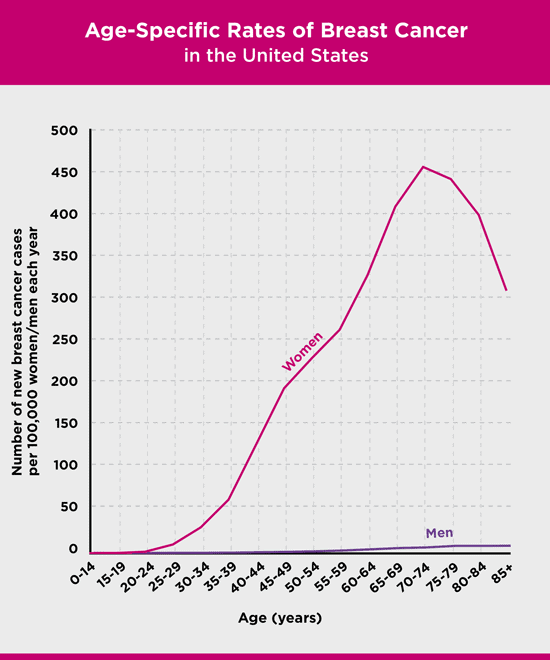Breast Cancer Risk Factors: Age
Age is an established risk factor for breast cancer.
Learn about other factors linked to the risk of breast cancer.
Breast cancer in women
The older a woman is, the more likely she is to get breast cancer.
Rates of breast cancer are low in women under 40. About 4% of women diagnosed with breast cancer in the U.S. are younger than 40 [6].
Rates begin to increase after age 40 and are highest in women over age 70 (see Figure 2.1 below).
Age at diagnosis
From 2016 to 2020 (most recent data available), the median age of diagnosis of breast cancer for women in the U.S. was 63 [7]. The median is the middle value of a group of numbers, so about half of women with breast cancer are diagnosed before age 63 and about half are diagnosed after age 63.
The median age of breast cancer diagnosis varies by race and ethnicity.
Race and ethnicity |
Median age of breast cancer diagnosis in women |
Non-Hispanic White |
65 |
Non-Hispanic American Indian and Alaska Native |
61 |
Non-Hispanic Black |
61 |
Non-Hispanic Asian and Pacific Islander |
58 |
Hispanic |
58 |
Source: 2016-2020 SEER data, 2023 [7] |
|
For example, non-Hispanic Black women tend to be diagnosed at a younger age than non-Hispanic white women [7]. From 2016 to 2020 (most recent data available), the median age at diagnosis for non-Hispanic Black women was 61, compared to 65 for non-Hispanic white women [7].
Learn more about race, ethnicity and breast cancer risk.
Breast cancer in men
The older a man is, the more likely he is to get breast cancer.
Age at diagnosis
From 2016 to 2020 (most recent data available), the median age of diagnosis of breast cancer for men in the U.S. was 68 [8]. The median is the middle value of a group of numbers, so about half of men with breast cancer are diagnosed before age 68 and about half are diagnosed after age 68.
The median age of breast cancer diagnosis varies by race and ethnicity.
Race and ethnicity |
Median age of breast cancer diagnosis in men |
Non-Hispanic White |
69 |
Non-Hispanic Asian and Pacific Islander |
65 |
Non-Hispanic Black |
65 |
Hispanic |
64 |
Non-Hispanic American Indian and Alaska Native |
Not available |
Source: 2016-2020 SEER data, 2023 [8] |
|
For example, non-Hispanic Black men tend to be diagnosed at a younger age than non-Hispanic white men [8]. From 2016 to 2020 (most recent data available), the median age at diagnosis for non-Hispanic Black men was 65, compared to 69 for non-Hispanic white men [8].
Learn more about breast cancer in men.
Learn more about race, ethnicity and breast cancer risk.
Why is age related to breast cancer risk?
The older we are, the more likely abnormal changes will occur in our cells. When many of these changes occur, cancer can develop.
Figure 2.1
|
Data source: SEER 2016-2020 [9] Note: Although this graph shows a rate of 0 in some age groups, there are a few cases of breast cancer in these age groups. However, the numbers are too small to appear on the scale used here. |
Learn about other factors linked to the risk of breast cancer.
Updated 04/29/24

